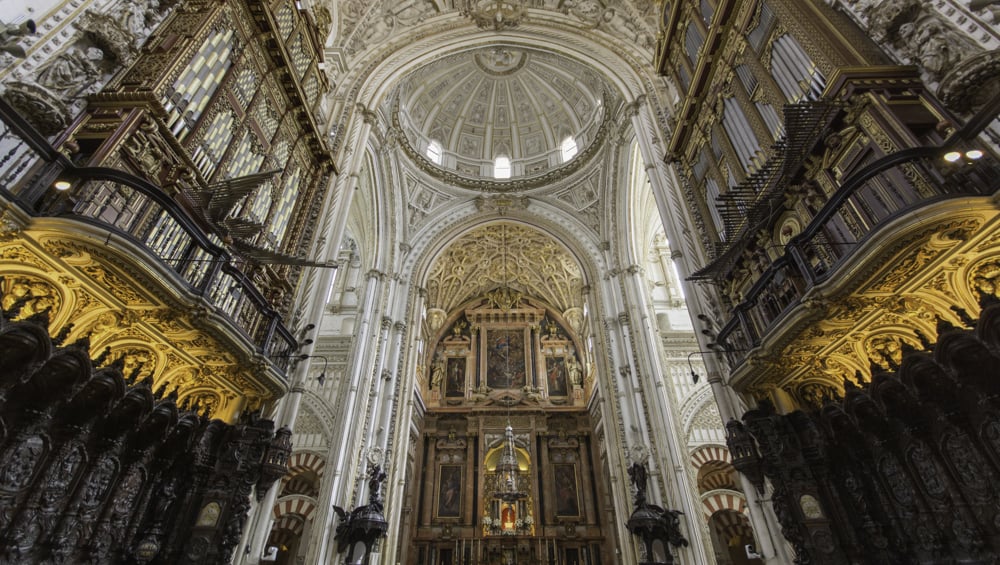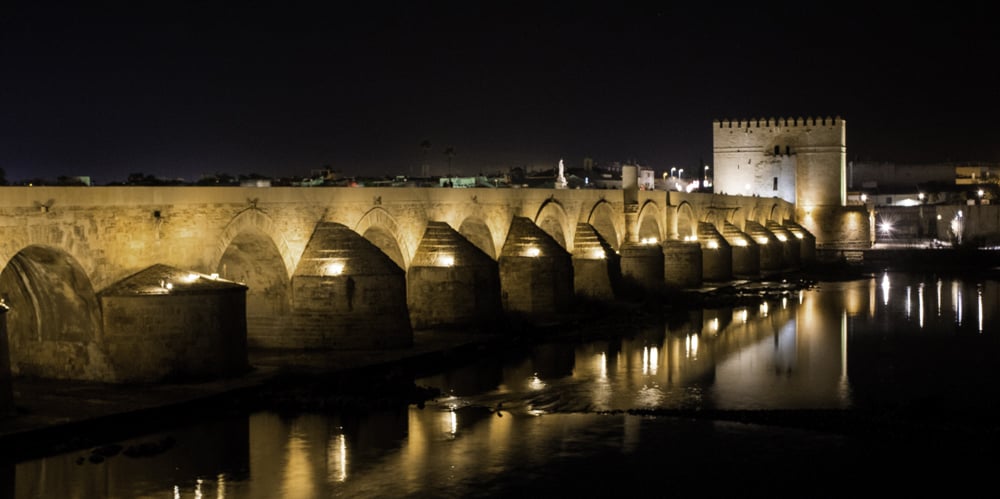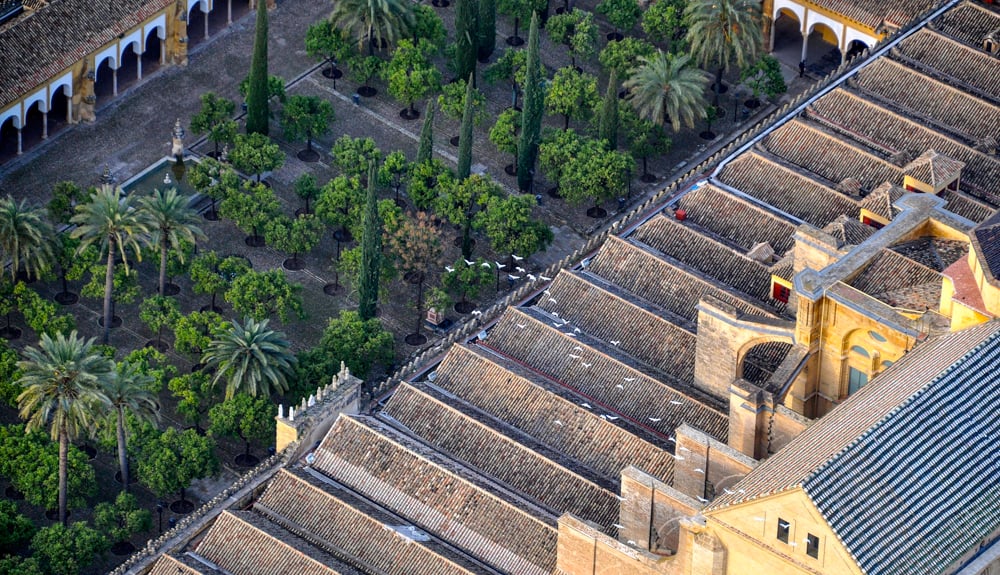If you don’t know what to see in Cordoba and you are thinking of visiting the city, here are the 10 best rated places according to the main travel websites. In this post you will know the main monuments of the city, or at least the most visited by tourists. If this is your first time in Cordoba, here are the must-sees.
Do you already know these places? Then discover 10 charming places and activities in Cordoba and take a look at these unforgettable visits to the city of Cordoba.
What you will find here
Mezquita and Cathedral of Cordoba
Majestic architecture that represents the first centuries of Islam in the Iberian Peninsula and which later became the most original cathedral in Spain and probably in Europe. But as if that were not enough, under its pavement lie the ruins of Roman mosaics and a primitive Visigothic temple of the Church of San Vicente Mártir.
This temple is the main attraction of Cordoba and thousands of visitors from all over the world come every year. We are not going to tell you much about its history, but we are going to tell you about the experience of visiting it. Mihrab, Maqsura, Altar of the Cathedral and other important places are usually crowded, but try get lost in the forest of columns. The mosque is so large that you’ll always find secluded, quiet places to take a deep breath and evoke the times when the floor was carpeted and candlelight illuminated the halls. It is undoubtedly a place charged with spirituality and solemnity that is sometimes difficult to perceive amidst the comings and goings of groups.

View of the main altar from the choir. Cathedral of Cordoba.
Alcázar of the Christian Kings
It was the residence of the Andalusian governors and, as usual, after the conquest of Cordoba in 1236, it became the property of the Crown of Castile. Alfonso X the Wise began its remodelling and for centuries it was the Royal House, but time took it in other directions, as it was the seat of the Holy Inquisition and a prison in the 19th century. As it happens in the ancient cities of Andalusia, under each monument there is always another one and the subsoil of the Alcazares preserves Roman and Visigothic remains.
The interesting thing about this place is the spaciousness of its courtyards and garden areas. The visit becomes a pleasant stroll amidst the sound of water and birdsong. Exotic flowers and aromatic plants have been placed in the flowerbeds, making a visit in spring a delight for the sense of smell.

Alcazar of the Christian Monarchs of Cordoba, one of its main courtyards in spring.
Roman Bridge
Its 16 spans, originally 17, cross the mighty Guadalquivir River as it passes through Cordoba. Nowadays there are many more bridges, but in the past it was the only place to cross the river in that area and without a boat, so its importance was more than relevant. It leads directly to the heart of the historic centre and the Mosque-Cathedral.
Although they call it the Roman Bridge, it still has the layout and foundations from that period, which is no mean feat. Imagine a foundation in the riverbed 2000 years old. Reforms have taken place throughout its history as it has always maintained its functionality. Before 2004 you could still cross it by car, but nowadays it is a delightful pedestrian walkway over the river.
On the right bank of the river it is flanked by the Puerta del Puente and on the left by the Torre de la Calahorra. Next to the former was an office for the collection of municipal taxes on the traffic of goods and the sanitary control of the city.
However, we would like to draw attention to the surroundings of the river. On the left bank of the river, a leafy promenade was built along the river. It provides partial access to the natural monument Sotos de la Albolafia. This is a small protected area bordering the city itself, where birds in danger of extinction nest. Willows, oleanders and poplars populate the riverbank and enclose several mills, some dating from the Andalusian period.
HERE EVERYTHING ABOUT THE ROMAN CORDOBA

Roman Bridge at sunset from the right bank of the Guadalquivir River.
Synagogue
Don’t be confused when you enter, although the plasterwork and other decorations remind you of the Andalusian style, this is a Jewish temple which was also built when Cordoba was no longer under Muslim rule. Its Mudejar style and the epigraphy on its walls is Hebrew. In fact, an inscription has been preserved stating that it was built in 1315 by the master builder Isaq Moheb.
The fact that it is preserved today is the result of the reuse of the space first as a hospital, then as a hermitage and then as a school in the 19th century. Today it is open to the public and its splendour has been partially restored through stylistic reconstructions. When visiting the synagogue try to visualise its colourful walls, because this is how it was originally.

Synagogue of Cordoba (JP Puerta. Flickr. CC2.0).
Madinat al-Zahara
Better known by the Castilianisation of the Arabic voice as Medina Azahara, this colossal palatine city was the headquarters of the Umayyad rulers who established first the emirate and then the Caliphate with its capital at Córdoba. This place was the latest Andalusian addition to the list of World Heritage Sites in 2018.
It is an almost obligatory visit, as wandering through its ruins is an experience in which to learn about the history of the greatest al-Andalus. At most of the sites you will have to make the effort to fill in what is missing with your imagination. But if you visit the modern interpretation centre first, it will be much easier.
Although it looks big to you, only 15% of it is visible today. Aerial photographs have determined that the extent of Madinat al-Zahara was infinitely larger. Furthermore, the road leading to Córdoba was dotted with “Almunias“, bridges and other buildings of which archaeological remains have been preserved.

Ruins of Medina al-Zahara.
Patio de los Naranjos (Orange Tree Courtyard)
Although it is part of the Mosque, access is free and it can be visited separately from the temple. Why it is called the Orangery is no mystery. In the springtime, the smell of orange blossom fills the whole courtyard, one of the most characteristic perfumes of Andalusia. But if you think that during the Middle Ages this courtyard was full of orange trees, you are mistaken. Its almost 100 orange trees were planted in rows in the 18th century.
The other fundamental element of the mosque’s courtyard is the water. It is essential for ablutions; the purification or cleansing prior to prayer in Islamic culture. Today none of the fountains that supplied water to the Andalusians who went to the mosque every day remain. However, inside the courtyard there are two large fountains of crystal-clear water dating from the 17th and 18th centuries, and three more outside the walls.

Aerial view of the Patio de los Naranjos (Toni Castillo Quero. Wikicommons. CC BY-SA 2.0).
Almodóvar Gate
The name of things is never in vain. From the Puerta de Almodóvar starts the road to Almodóvar del Río, a town near the capital. It is of Arabic origin and its first known name is Bab al-Chawz, which is interpreted as the Gate of the Walnut Tree or of Badajoz. It was rebuilt in the 14th century and its current appearance corresponds to that of that period.
In addition to evoking that medieval world in which the cities were protected by large walls, outside the walls there is a small park with ponds where you can take a break from walking in the old quarter. To the south is Calle Cairuán, which runs along the wall and moat in the direction of the Caliph Baths of the Alcázar, another place to visit.

Puerta de Almodovar and the wall to the south (Michael Bryan. Wikicommons. CC BY 2.0.)
La Puerta del Puente (Bridge Gate)
If you ask about the Puerta del Puente in Córdoba you may not find an answer. This is because this monument is popularly known as the Arco del Triunfo, in fact it was called that for some years. However, this gate is part of the old city wall. In the second half of the 16th century it began to be remodelled in order to enlarge and embellish it to feast the entry of Philip II into the city. It is located on the right bank of the Guadalquivir, aligned with the Roman Bridge and, in its day, was the main access to the city from the south.
When you cross it, imagine that you are passing through history. Thousands of people have crossed it over hundreds of years, from the humblest citizens to illustrious personalities and kings. It is not easy to visualise it adorned with flowers and guarded by troops on the arrival of royalty to the city, but that is how it was. Today it is an exempt monument, contemplated and one of the most photographed.

Puerta del Puente, early in the morning.
A LITTLE HINT
To introduce you our guided tours in Cordoba, click on the banner to know them all.
Maimonides’ statue
Among the many things that Cordoba can boast, being the cradle of great thinkers is one of the most important. Among them is Moše ibn Maymón, known as Maimonides, a Cordovan Jew dedicated to philosophy and born in 1135. His life was a constant journey that began with the religious pressure exerted by the Almohads in the 12th century. After passing through various places in al-Andalus, he lived for some years in Almería. From there he went to Fez (Morocco), then Palestine and finally Egypt.
He composed poetry, wrote on Talmudic religion and philosophy, practised medicine with which he achieved fame in Egypt and was a leader of the Jewish community. In his honour, a copper statue was erected in 1964 in Tiberias Square, in the heart of the Jewish quarter. The illustrious figure is seated while holding a book in his hand.
The key to his philosophical thought revolves around the reconciliation of faith and reason. This is why he was followed by his disciples and criticised by his detractors. Basically Maimonides called for the use of reason as opposed to the literal interpretation of the sacred scriptures. A man ahead of his time.

Sculpture of Maimonides in a small Cordovan square in the Jewish quarter.
Roman Temple
Sometimes the imposing mosque overshadows Cordoba’s valuable Roman past. For years, capitals and other classical marble elements were frequently found in the area around the Town Hall, until the remains of the temple were discovered in 1950 during the course of extension work.
It was built in the second half of the 1st century, which means that it is very close to 2000 years old. It was located in the centre of a large square and is considered to be dedicated to the deified emperors of the Roman Empire.
The present appearance, and especially the large complete columns, corresponds to a reconstruction of the 1950s on the preserved plinth. In the surrounding area you can also see some decorative remains out of their original position and part of the wall from the same period. If you are as passionate about Roman culture as we are, we recommend you to take a look at our guide to Roman Cordoba, you will love it.

Roman temple ruins reconstructed.
MAP OF WHAT TO SEE IN CORDOBA
In the map we show you the location of the places to see in Cordoba described in this post.

